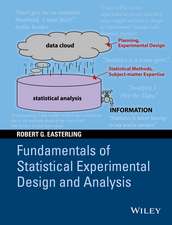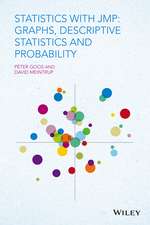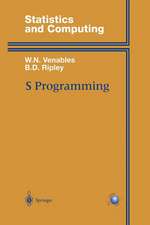Finite Mixture and Markov Switching Models: Springer Series in Statistics
Autor Sylvia Frühwirth-Schnatteren Limba Engleză Hardback – 8 aug 2006
| Toate formatele și edițiile | Preț | Express |
|---|---|---|
| Paperback (1) | 1226.73 lei 6-8 săpt. | |
| Springer – 19 noi 2010 | 1226.73 lei 6-8 săpt. | |
| Hardback (1) | 1232.41 lei 6-8 săpt. | |
| Springer – 8 aug 2006 | 1232.41 lei 6-8 săpt. |
Din seria Springer Series in Statistics
- 14%
 Preț: 679.60 lei
Preț: 679.60 lei - 20%
 Preț: 630.98 lei
Preț: 630.98 lei - 20%
 Preț: 816.45 lei
Preț: 816.45 lei - 20%
 Preț: 1000.85 lei
Preț: 1000.85 lei -
 Preț: 390.84 lei
Preț: 390.84 lei - 20%
 Preț: 697.14 lei
Preț: 697.14 lei - 20%
 Preț: 445.20 lei
Preț: 445.20 lei - 20%
 Preț: 884.71 lei
Preț: 884.71 lei - 18%
 Preț: 1237.14 lei
Preț: 1237.14 lei - 18%
 Preț: 961.82 lei
Preț: 961.82 lei - 18%
 Preț: 956.50 lei
Preț: 956.50 lei - 18%
 Preț: 794.25 lei
Preț: 794.25 lei - 15%
 Preț: 648.05 lei
Preț: 648.05 lei - 18%
 Preț: 1217.10 lei
Preț: 1217.10 lei - 15%
 Preț: 646.11 lei
Preț: 646.11 lei - 15%
 Preț: 647.08 lei
Preț: 647.08 lei - 15%
 Preț: 646.11 lei
Preț: 646.11 lei - 18%
 Preț: 1329.76 lei
Preț: 1329.76 lei - 15%
 Preț: 652.81 lei
Preț: 652.81 lei - 18%
 Preț: 1114.52 lei
Preț: 1114.52 lei - 18%
 Preț: 952.40 lei
Preț: 952.40 lei - 18%
 Preț: 1333.42 lei
Preț: 1333.42 lei - 18%
 Preț: 1561.68 lei
Preț: 1561.68 lei - 18%
 Preț: 1231.47 lei
Preț: 1231.47 lei - 15%
 Preț: 513.64 lei
Preț: 513.64 lei - 18%
 Preț: 893.71 lei
Preț: 893.71 lei - 15%
 Preț: 649.87 lei
Preț: 649.87 lei - 18%
 Preț: 1007.65 lei
Preț: 1007.65 lei - 18%
 Preț: 1111.67 lei
Preț: 1111.67 lei - 18%
 Preț: 1223.70 lei
Preț: 1223.70 lei - 18%
 Preț: 892.74 lei
Preț: 892.74 lei - 18%
 Preț: 913.26 lei
Preț: 913.26 lei - 18%
 Preț: 943.88 lei
Preț: 943.88 lei -
 Preț: 391.61 lei
Preț: 391.61 lei -
 Preț: 391.22 lei
Preț: 391.22 lei - 18%
 Preț: 1331.18 lei
Preț: 1331.18 lei -
 Preț: 390.84 lei
Preț: 390.84 lei - 18%
 Preț: 888.45 lei
Preț: 888.45 lei - 18%
 Preț: 960.61 lei
Preț: 960.61 lei - 18%
 Preț: 1245.34 lei
Preț: 1245.34 lei - 18%
 Preț: 964.54 lei
Preț: 964.54 lei - 15%
 Preț: 643.16 lei
Preț: 643.16 lei - 18%
 Preț: 1723.76 lei
Preț: 1723.76 lei - 15%
 Preț: 643.84 lei
Preț: 643.84 lei - 15%
 Preț: 586.37 lei
Preț: 586.37 lei - 18%
 Preț: 999.59 lei
Preț: 999.59 lei - 15%
 Preț: 643.34 lei
Preț: 643.34 lei - 18%
 Preț: 806.40 lei
Preț: 806.40 lei - 18%
 Preț: 727.66 lei
Preț: 727.66 lei
Preț: 1232.41 lei
Preț vechi: 1502.94 lei
-18% Nou
Puncte Express: 1849
Preț estimativ în valută:
235.83€ • 252.18$ • 196.62£
235.83€ • 252.18$ • 196.62£
Carte tipărită la comandă
Livrare economică 18 aprilie-02 mai
Preluare comenzi: 021 569.72.76
Specificații
ISBN-13: 9780387329093
ISBN-10: 0387329099
Pagini: 492
Ilustrații: XIX, 494 p.
Dimensiuni: 155 x 235 x 28 mm
Greutate: 0.87 kg
Ediția:2006
Editura: Springer
Colecția Springer
Seria Springer Series in Statistics
Locul publicării:New York, NY, United States
ISBN-10: 0387329099
Pagini: 492
Ilustrații: XIX, 494 p.
Dimensiuni: 155 x 235 x 28 mm
Greutate: 0.87 kg
Ediția:2006
Editura: Springer
Colecția Springer
Seria Springer Series in Statistics
Locul publicării:New York, NY, United States
Public țintă
ResearchCuprins
Finite Mixture Modeling.- Statistical Inference for a Finite Mixture Model with Known Number of Components.- Practical Bayesian Inference for a Finite Mixture Model with Known Number of Components.- Statistical Inference for Finite Mixture Models Under Model Specification Uncertainty.- Computational Tools for Bayesian Inference for Finite Mixtures Models Under Model Specification Uncertainty.- Finite Mixture Models with Normal Components.- Data Analysis Based on Finite Mixtures.- Finite Mixtures of Regression Models.- Finite Mixture Models with Nonnormal Components.- Finite Markov Mixture Modeling.- Statistical Inference for Markov Switching Models.- Nonlinear Time Series Analysis Based on Markov Switching Models.- Switching State Space Models.
Recenzii
From the reviews:
"At first glance, the numerous equations and formulas may seem to be daunting for psychologists with limited statistical background; however, the descriptions and explanations of the various models are actually quite reader friendly (more so than many advanced statistical textbooks). The author has done an excellent job of inviting newcomers to enter the world of mixture models, more impressively, the author did so without sacrificing mathematical and statistical rigor. Mixture models are appealing in many applications in social and psychological studies. This book not only offers a gentle introduction to mixture models but also provides more in depth coverage for those who look beyond the surface. I believe that psychologists who are interested in related models (e.g., latent class models, latent Markov models, and latent class regression models) will benefit greatly from this book. I highly recommend this book to all psychologists who are interested in mixture models." (Hsiu-Ting Yu, PSYCHOMETRIKA—VOL. 74, NO. 3, 559–560 SEPTEMBER 2009)
"The book is impressive in its mathematical and formal correctness, in generality and in details....it would be helfpful as an additional reference among a wider range of available textbooks in the area. [I]t will find many friends among experts and newcomers to the world of mixture models." (Atanu Biswas, Biometrics, Issue 63, September 2007)
"Finite mixture distributions are important for many models. Therefore they constitute a very active field of research. This book gives an up to date overview over the various models of this kind. … The aim of this book is to impart the finite mixture and Markov switching approach to statistical modeling to a wide-ranging community. … For the frequentists, it offers a good opportunity to explore the advantages of the Bayesian approach in the context of mixing models." (Gheorghe Pitis, Zentralblatt MATH, Vol. 1108(10), 2007)
"Readership: Statisticians, biologists, economists, engineers, financial agents, market researchers, medical researchers or any other frequent user of statistical models. The first nine chapters of the book are concerned with static mixture models, and the last four with Markov switching models. … especially valuable for students, serving to demonstrate how different statistical techniques, which superficially appear to be unrelated, are in fact part of an integrated whole. This book struck me as being particularly clearly written – it is a pleasure to read." (David J. Hand, International Statistical Review, Vol. 75 (2), 2007)
"The book is excellent, giving a most readable overview of the topic of finite mixtures, aimed at a broad readership … . Students will like the text because of the pedagogical writing style; researchers will definitely welcome the broad treatment of the subject. Both will benefit from the extensive and up-to-date bibliography … as well as the well-organized index. No doubt, this book is a valuable addition to the field of statistics and will surely find its rightful place in many a statistician’s library." (Valerie Chavez-Demoulin, Journal of the American Statistical Association, Vol. 104 (485), March, 2009)
"At first glance, the numerous equations and formulas may seem to be daunting for psychologists with limited statistical background; however, the descriptions and explanations of the various models are actually quite reader friendly (more so than many advanced statistical textbooks). The author has done an excellent job of inviting newcomers to enter the world of mixture models, more impressively, the author did so without sacrificing mathematical and statistical rigor. Mixture models are appealing in many applications in social and psychological studies. This book not only offers a gentle introduction to mixture models but also provides more in depth coverage for those who look beyond the surface. I believe that psychologists who are interested in related models (e.g., latent class models, latent Markov models, and latent class regression models) will benefit greatly from this book. I highly recommend this book to all psychologists who are interested in mixture models." (Hsiu-Ting Yu, PSYCHOMETRIKA—VOL. 74, NO. 3, 559–560 SEPTEMBER 2009)
"The book is impressive in its mathematical and formal correctness, in generality and in details....it would be helfpful as an additional reference among a wider range of available textbooks in the area. [I]t will find many friends among experts and newcomers to the world of mixture models." (Atanu Biswas, Biometrics, Issue 63, September 2007)
"Finite mixture distributions are important for many models. Therefore they constitute a very active field of research. This book gives an up to date overview over the various models of this kind. … The aim of this book is to impart the finite mixture and Markov switching approach to statistical modeling to a wide-ranging community. … For the frequentists, it offers a good opportunity to explore the advantages of the Bayesian approach in the context of mixing models." (Gheorghe Pitis, Zentralblatt MATH, Vol. 1108(10), 2007)
"Readership: Statisticians, biologists, economists, engineers, financial agents, market researchers, medical researchers or any other frequent user of statistical models. The first nine chapters of the book are concerned with static mixture models, and the last four with Markov switching models. … especially valuable for students, serving to demonstrate how different statistical techniques, which superficially appear to be unrelated, are in fact part of an integrated whole. This book struck me as being particularly clearly written – it is a pleasure to read." (David J. Hand, International Statistical Review, Vol. 75 (2), 2007)
"The book is excellent, giving a most readable overview of the topic of finite mixtures, aimed at a broad readership … . Students will like the text because of the pedagogical writing style; researchers will definitely welcome the broad treatment of the subject. Both will benefit from the extensive and up-to-date bibliography … as well as the well-organized index. No doubt, this book is a valuable addition to the field of statistics and will surely find its rightful place in many a statistician’s library." (Valerie Chavez-Demoulin, Journal of the American Statistical Association, Vol. 104 (485), March, 2009)
Textul de pe ultima copertă
The prominence of finite mixture modelling is greater than ever. Many important statistical topics like clustering data, outlier treatment, or dealing with unobserved heterogeneity involve finite mixture models in some way or other. The area of potential applications goes beyond simple data analysis and extends to regression analysis and to non-linear time series analysis using Markov switching models.
For more than the hundred years since Karl Pearson showed in 1894 how to estimate the five parameters of a mixture of two normal distributions using the method of moments, statistical inference for finite mixture models has been a challenge to everybody who deals with them. In the past ten years, very powerful computational tools emerged for dealing with these models which combine a Bayesian approach with recent Monte simulation techniques based on Markov chains. This book reviews these techniques and covers the most recent advances in the field, among them bridge sampling techniques and reversible jump Markov chain Monte Carlo methods.
It is the first time that the Bayesian perspective of finite mixture modelling is systematically presented in book form. It is argued that the Bayesian approach provides much insight in this context and is easily implemented in practice. Although the main focus is on Bayesian inference, the author reviews several frequentist techniques, especially selecting the number of components of a finite mixture model, and discusses some of their shortcomings compared to the Bayesian approach.
The aim of this book is to impart the finite mixture and Markov switching approach to statistical modelling to a wide-ranging community. This includes not only statisticians, but also biologists, economists, engineers, financial agents, market researcher, medical researchers or any other frequent user of statistical models. This book should help newcomers to the field to understand how finite mixture andMarkov switching models are formulated, what structures they imply on the data, what they could be used for, and how they are estimated. Researchers familiar with the subject also will profit from reading this book. The presentation is rather informal without abandoning mathematical correctness. Previous notions of Bayesian inference and Monte Carlo simulation are useful but not needed.
Sylvia Frühwirth-Schnatter is Professor of Applied Statistics and Econometrics at the Department of Applied Statistics of the Johannes Kepler University in Linz, Austria. She received her Ph.D. in mathematics from the University of Technology in Vienna in 1988. She has published in many leading journals in applied statistics and econometrics on topics such as Bayesian inference, finite mixture models, Markov switching models, state space models, and their application in marketing, economics and finance.
For more than the hundred years since Karl Pearson showed in 1894 how to estimate the five parameters of a mixture of two normal distributions using the method of moments, statistical inference for finite mixture models has been a challenge to everybody who deals with them. In the past ten years, very powerful computational tools emerged for dealing with these models which combine a Bayesian approach with recent Monte simulation techniques based on Markov chains. This book reviews these techniques and covers the most recent advances in the field, among them bridge sampling techniques and reversible jump Markov chain Monte Carlo methods.
It is the first time that the Bayesian perspective of finite mixture modelling is systematically presented in book form. It is argued that the Bayesian approach provides much insight in this context and is easily implemented in practice. Although the main focus is on Bayesian inference, the author reviews several frequentist techniques, especially selecting the number of components of a finite mixture model, and discusses some of their shortcomings compared to the Bayesian approach.
The aim of this book is to impart the finite mixture and Markov switching approach to statistical modelling to a wide-ranging community. This includes not only statisticians, but also biologists, economists, engineers, financial agents, market researcher, medical researchers or any other frequent user of statistical models. This book should help newcomers to the field to understand how finite mixture andMarkov switching models are formulated, what structures they imply on the data, what they could be used for, and how they are estimated. Researchers familiar with the subject also will profit from reading this book. The presentation is rather informal without abandoning mathematical correctness. Previous notions of Bayesian inference and Monte Carlo simulation are useful but not needed.
Sylvia Frühwirth-Schnatter is Professor of Applied Statistics and Econometrics at the Department of Applied Statistics of the Johannes Kepler University in Linz, Austria. She received her Ph.D. in mathematics from the University of Technology in Vienna in 1988. She has published in many leading journals in applied statistics and econometrics on topics such as Bayesian inference, finite mixture models, Markov switching models, state space models, and their application in marketing, economics and finance.
Caracteristici
Mixture models are nowadays applied in many different areas such as biometrics, medicine, marketing whereas switching models are applied essentially in economics and finance















